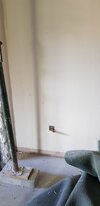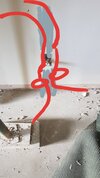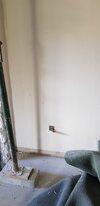- Joined
- 4 Jan 2012
- Messages
- 351
- Reaction score
- 7
- Country

Hi guys
Just after some info concerning extending my ring main. Got all the planning application in and it will all be signed off - I want to extend the ring main into my extension all the current sockets are fed from under the floorboards so not just a question of adding some junction boxes and extending that way.
My thought is I have a socket which is the closest and access underneath while the ceiling is down. My thoughts are to pull those 2 cables back and join the new cable using a wago chase the top of the socket and run the new cable up into the loft around and down to feed the new sockets and then back to the original socket as above joining to the other cable again with a wago.
My question is, is this is the best way? And am I ok to use one of these cables to feed the socket here and effectively having tge other just passing through so to speak?
Excuse the crappy picture
Just after some info concerning extending my ring main. Got all the planning application in and it will all be signed off - I want to extend the ring main into my extension all the current sockets are fed from under the floorboards so not just a question of adding some junction boxes and extending that way.
My thought is I have a socket which is the closest and access underneath while the ceiling is down. My thoughts are to pull those 2 cables back and join the new cable using a wago chase the top of the socket and run the new cable up into the loft around and down to feed the new sockets and then back to the original socket as above joining to the other cable again with a wago.
My question is, is this is the best way? And am I ok to use one of these cables to feed the socket here and effectively having tge other just passing through so to speak?
Excuse the crappy picture





